Today, let’s see together how to apply Exploratory Data Analysis (EDA) on a NLP dataset: feedback-prize-effectiveness.
In a previous article we saw how to do EDA to prevent environmental disasters. Thanks to meteorological data, we analyzed the causes of forest fires.
Here I propose to apply the same analysis on text data thanks to the feedback-prize-effectiveness dataset.
This dataset is taken from the Kaggle competition of the same name: Feedback Prize – Predicting Effective Arguments.
The main objective of this competition is to create a Machine Learning algorithm able to predict the effectiveness of a discourse. Here we will see in detail the Exploratory Data Analysis (EDA) that will allow us to understand our dataset.
Data
First thing to do, download the dataset. Either by registering to the Kaggle contest, or by downloading it on this Github.
Then you can open it with Pandas and display dimensions:
import pandas as pd
df = pd.read_csv("train.csv")
df.shapeOutput: (36765, 5)
We have 36.765 rows so 36.765 discourses for 5 columns.
Now let’s see what these columns represent by displaying their types:
df.dtypesI display here the type of the columns and their description:
discourse_id– object – discourse IDessay_id– object – ID of the essay (an essay can be composed of several discourses)discourse_text– object – Discourse textdiscourse_type– object – Type of discoursediscourse_effectiveness– object – Effectiveness of the discourse
2 ID columns, one column representing text and 2 columns for Labels. The one we are most interested in is discourse_effectiveness as it is the target to predict.
Then we can display our data:
df.head()
Now that we have a good overview of the dataset, we can start EDA!
To do this, we’ll go through the classic steps of the process:
- Understand our dataset with the Univariate Analysis
- Drawing hypotheses with the Multivariate Analysis
Univariate Analysis
Univariate analysis is the fact of examining each feature separately.
This will allow us to get a deeper understanding of the dataset.
Here, we are in the comprehension phase.
The question associated with the Univariate Analysis is: What is the characteristics of the data that compose our dataset?
Target
As we noticed above, the most interesting column for us is the target discourse_effectiveness. This column indicates the effectiveness of a discourse.
Each line, each discourse, can have a different effectiveness. We classify them according to 3 levels:
IneffectiveAdequateEffective
Let’s see how these 3 classes are distributed in our dataset:
import seaborn as sns
import matplotlib.pyplot as plt
stats_target = df['discourse_effectiveness'].value_counts(normalize=True)
print(stats_target)
plt.figure(figsize=(14,5))
plt.subplot(1,2,1)
sns.countplot(data=df,y='discourse_effectiveness')
plt.subplot(1,2,2)
stats_target.plot.bar(rot=25)
plt.ylabel('discourse_effectiveness')
plt.xlabel('% distribution per category')
plt.tight_layout()
plt.show()Output:
Adequate: 0.57
Effective: 0.25
Ineffective: 0.17

Here you can see the numerical distribution, but also the statistical one which is easier to analyze.
57% of the discourses are Adequate, the rest are either Effective or Ineffective.
Ideally, we would have needed more Ineffective discourses to have a better balanced and therefore generalizable dataset. Since we have no influence on the data, let’s continue with what we have!
Categorical Data
Now I propose to analyze the types of discourses.
There are seven types:
- Lead – an introduction that begins with a statistic, quote, description, or other means of getting the reader’s attention and directing them to the thesis
- Position – an opinion or conclusion on the main issue
- Claim – a statement that supports the position
- Counterclaim – a claim that refutes another claim or gives a reason opposite to the position
- Rebuttal – a statement that refutes a counterclaim
- Evidence – ideas or examples that support assertions, counterclaims or rebuttals
- Concluding Statement – a final statement that reaffirms the claims
Given the different types, it would seem logical that there are fewer Counterclaims and Rebuttal than other types.
Furthermore, I would like to remind here that several discourses, several lines, can be part of the same essay (essay_id). That is, several discourses can be written by the same author, in the same context. And so an essay can contain several discourse having different types as well as different degrees of effectiveness.
Let us now analyze the distribution of this discourse_type:
import seaborn as sns
import matplotlib.pyplot as plt
plt.figure(figsize=(14,5))
plt.subplot(1,2,1)
sns.countplot(data=df,y='discourse_type')
plt.subplot(1,2,2)
df['discourse_type'].value_counts(normalize=True).plot.bar(rot=25)
plt.ylabel('discourse_type')
plt.xlabel('% distribution per category')
plt.tight_layout()
plt.show()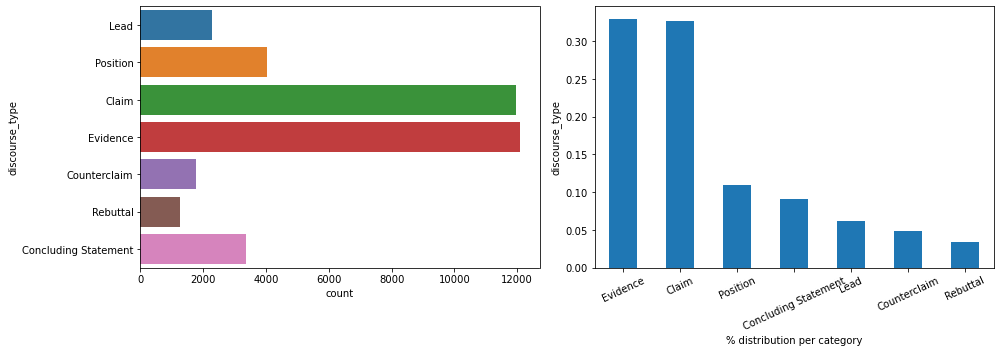
We can see here that the distribution is not equally distributed. Our hypothesis is verified for Counterclaim and Rebuttal. Nevertheless, the distribution is extremely unbalanced in favor of Claim and Evidence. Let’s keep that in mind for further analysis.
NLP Data
Discourse Length
Now that we have analyzed the categorical data. We can move on to analyze the NLP data.
First, let’s analyze the length of our sentences.
To do this, we create a new column discourse_length containing the size of each discourse:
def length_disc(discourse_text):
return len(discourse_text.split())
df['discourse_length'] = df['discourse_text'].apply(length_disc)Let’s display the result:
df.head()
Now we can examine the discourse_length column like any other numeric data:
plt.figure(figsize=(12,4))
plt.subplot(1,2,1)
sns.kdeplot(df['discourse_length'],color='g',shade=True)
plt.subplot(1,2,2)
sns.boxplot(df['discourse_length'])
plt.show()
It looks like there are a lot of values that are extremely far from the mean. These are called outliers and they impact our analysis. We can’t properly breakdown the Tukey box on the right.
Let’s zoom in on the graph:
plt.figure(figsize=(12,4))
plt.subplot(1,2,1)
sns.kdeplot(df['discourse_length'],color='g',shade=True)
plt.subplot(1,2,2)
sns.boxplot(df['discourse_length'])
plt.show()
That’s better! Most discourses are less than 120 words long, with the average being about 30 words.
Despite this, it seems that there are many discourses above 120 words. Let’s analyze these outliers.
First, by calculating Skewness and Kurtosis. Two measures, detailed in this article, that help us to understand outliers and their distribution:
print("Skew: {}".format(df['discourse_length'].skew()))
print("Kurtosis: {}".format(df['discourse_length'].kurtosis()))Output:
Skew: 2.92
Kurtosis: 15.61
The outliers are widely spaced from the average with a very high Kurtosis.
Outliers
In most distributions, it is normal to have extreme values.
But outliers are not very frequent, even anomalous. It can be an error in the dataset.
Therefore, let’s display these outliers to determine if it is an error.
To determine outliers, we use the z-score.
Z-score calculates the distance of a point from the mean.
If the z-score is less than -3 or greater than 3, it is considered an outlier.
Let’s see this by displaying all points below -3 and above 3:
from scipy.stats import zscore
y_outliers = df[abs(zscore(df['discourse_length'])) >= 3 ]
y_outliers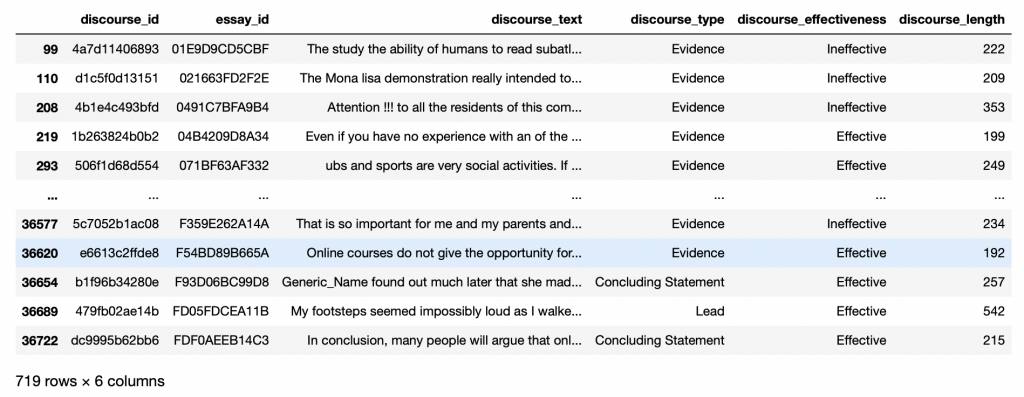
719 lines are outliers. They do not seem to represent errors. We can consider these lines as discourses that have not been separated in multiple essays (to be checked).
Let’s display the distribution of the efficiency of these outliers:
stats_long_text = y_outliers['discourse_effectiveness'].value_counts(normalize=True)
print(stats_long_text)
stats_long_text.plot.bar(rot=25)Output:
Effective: 0.53
Ineffective: 0.34
Adequate: 0.12

Here, a first hint emerges. Most long discourses seem to be Effective at about 53%. This is much more than in the whole dataset (25%).
We can therefore formulate a first hypothesis: the longer a discourse is, the more Effective it seems.
But we can also see that it can be more frequently Ineffective (34%) than a discourse of normal length (17%).
Let us display the distribution of types for these outliers:
stats_long_text = y_outliers['discourse_type'].value_counts(normalize=True)
print(stats_long_text)
stats_long_text.plot.bar(rot=25)Output:
Evidence: 0.93
Concluding Statement: 0.03
Lead: 0.02
Counterclaim: 0.001
Rebuttal: 0.001
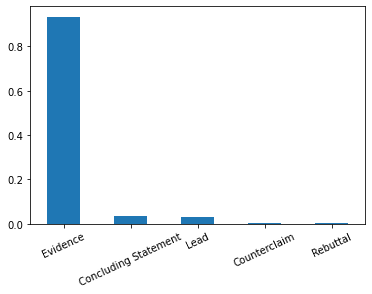
On this point, the statistic is very clear. Most long discourses are Evidence.
But are most Evidence discourses Effective?
We will see this in the Multivariate Analysis.
For now, let’s continue with the analysis of the words that make up the discourses!
Preprocessing
In order to analyze the words that compose the discourses, we will first perform a preprocessing by removing:
- numbers
- stopwords
- special characters
Here I copy and paste the code from the Preprocessing NLP – Tutorial to quickly clean up a text and applying a few changes:
import nltk
import string
from nltk.stem import WordNetLemmatizer
import re
nltk.download('stopwords')
nltk.download('punkt')
nltk.download('words')
nltk.download('wordnet')
stopwords = nltk.corpus.stopwords.words('english')
words = set(nltk.corpus.words.words())
lemmatizer = WordNetLemmatizer()
def preprocessSentence(sentence):
sentence_w_punct = "".join([i.lower() for i in sentence if i not in string.punctuation])
sentence_w_num = ''.join(i for i in sentence_w_punct if not i.isdigit())
tokenize_sentence = nltk.tokenize.word_tokenize(sentence_w_num)
words_w_stopwords = [i for i in tokenize_sentence if i not in stopwords]
words_lemmatize = (lemmatizer.lemmatize(w) for w in words_w_stopwords)
words_lemmatize = (re.sub(r"[^a-zA-Z0-9]","",w) for w in words_lemmatize)
sentence_clean = ' '.join(w for w in words_lemmatize if w.lower() in words or not w.isalpha())
return sentence_clean.split()As an example let’s display a base sentence and a preprocessed one:
print(df.iloc[1]['discourse_text'])
print('\n')
print(preprocessSentence(df.iloc[1]['discourse_text']))Output:
On my perspective, I think that the face is a natural landform because I dont think that there is any life on Mars. In these next few paragraphs, I’ll be talking about how I think that is is a natural landform
[‘perspective’, ‘think’, ‘face’, ‘natural’, ‘dont’, ‘think’, ‘life’, ‘mar’, ‘next’, ‘paragraph’, ‘ill’, ‘talking’, ‘think’, ‘natural’]
Now let’s apply the preprocessing to the whole DataFrame:
df_words = df['discourse_text'].apply(preprocessSentence)We get the result in df_words.
Word Analysis
We now have a DataFrame containing our preprocessed discourses. Each line represents a list containing the words composing discourses.
I would like to perform a one-hot encoding here. Again the process is explained in our article on NLP Preprocessing.
The idea of one-hot encoding is to have columns representing every words in the dataset, and rows indicating 1 if the word is present in the discourse, 0 otherwise.
If you have enough memory space use this line to make the one-hot encoding:
#dfa = pd.get_dummies(df_words.apply(pd.Series).stack()).sum(level=0)Otherwise use the concat option by splitting your dataset in two(or more) and one hot encoding the parts separately.
Finish by concatenating them:
dfa1 = pd.get_dummies(df_words.iloc[:20000].apply(pd.Series).stack()).sum(level=0)
dfa2 = pd.get_dummies(df_words.iloc[20000:].apply(pd.Series).stack()).sum(level=0)
dfb = pd.concat([dfa1,dfa2], axis=0, ignore_index=True)If you have used the concat option, you need now to replace the NaN with 0:
dfb = dfb.fillna(0).astype(int)We display the result:
dfb.head()
The dataset is now one hot encoded!
This will allow us to count the number of occurrences of each word more easily:
words_sum = dfb.sum(axis = 0).TThe words_sum DataFrame contains the number of times each word appears.
It is now sorted alphabetically from A to Z but I’d like to analyze the words that appear the most often.
So let’s sort words_sum by decreasing order of occurrence:
words_sum = words_sum.sort_values(ascending=False)Now let’s display the words that appear most often in our dataset:
words_sum_max = words_sum.head(20)
plt.figure(figsize=(16,5))
words_sum_max.plot.bar(rot=25)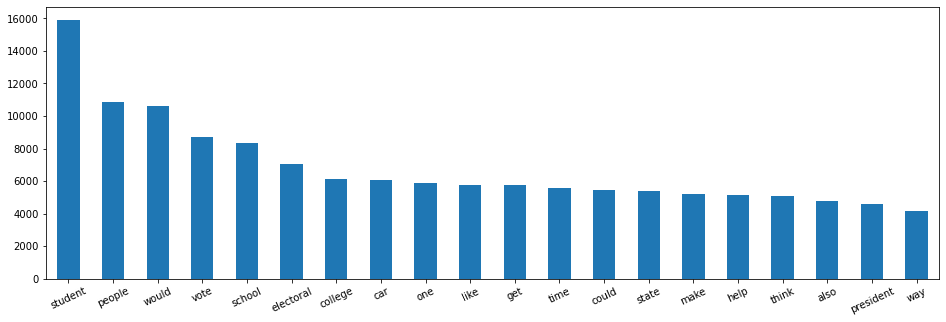
‘student’, ‘people’, ‘would’, ‘vote’, ‘school’, …
These words refer to school and elections. At this point, we can’t say much about these words.
It is interesting to display them now in order to compare them later during the Multivariate Analysis.
Indeed, the most frequent words in the global dataset may not be the same as in the Effective discourse.
Multivariate Analysis
We now have a much more accurate view of our dataset by analyzing:
- Effectiveness (target)
- Discourse types
- Length of the discourses
- Words that make up discourses
Let’s move on to the Multivariate Analysis.
Multivariate Analysis is the examination of our features by putting them in relation with our target.
This will allow us to make hypotheses about the dataset.
Here we are in the theorization phase.
The question associated with Multivariate Analysis is: Is there a link between our features and the target?
Categorical Data
First, let’s start with the categorical data.
By the way, if your goal is to master Deep Learning - I've prepared the Action plan to Master Neural networks. for you.
7 days of free advice from an Artificial Intelligence engineer to learn how to master neural networks from scratch:
- Plan your training
- Structure your projects
- Develop your Artificial Intelligence algorithms
I have based this program on scientific facts, on approaches proven by researchers, but also on my own techniques, which I have devised as I have gained experience in the field of Deep Learning.
To access it, click here :
Now we can get back to what I was talking about earlier.
Is there a relationship between discourse types (discourse_type) and their effectiveness (discourse_effectiveness)?
We display the number of occurrences of each of these types as a function of effectiveness:
import numpy as np
plt.figure(figsize=(8,8))
cross = pd.crosstab(index=df['discourse_effectiveness'],columns=df['discourse_type'],normalize='index')
cross.plot.barh(stacked=True,rot=40,cmap='plasma').legend(bbox_to_anchor=(1.0, 1.0))
plt.xlabel('% distribution per category')
plt.xticks(np.arange(0,1.1,0.2))
plt.title("Forestfire damage each {}".format('discourse_type'))
plt.show()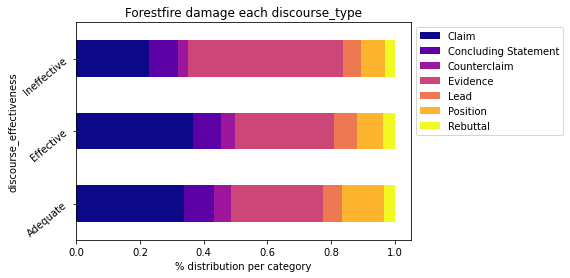
Impressive! At first glance, one can see that the more a discourse is of Claim type, the more Effective it is.
But is this really the case?
If we go back to our Univariate Analysis, we can see that Claim and Evidence are overrepresented types in our dataset. It is therefore logical to see them overrepresented in this analysis.
In fact, it would be more logical to evaluate this distribution in a statistical way. Thus all discourse_type would have the same weight in the dataset and the analysis would not be biased.
For example we have only 2.291 Lead against 12.105 Evidence. So there will be more Evidence in our analysis. This creates an imbalance. For Effective, we have 2,885 Evidence and 683 Lead. Does this mean that an Evidence discourse is more effective than a Lead discourse?
To clarify this, we need to perform a normalized analysis.
Normalization
To give the same weight to each discourse_type in the dataset, we need to normalize their occurrences.
We start by taking the number of occurrences of each discourse_type according to the discourse_effectiveness:
cross_norm = pd.crosstab(index=df['discourse_effectiveness'],columns=df['discourse_type'])
Then we count the total number of occurrences of each discourse_type:
count_type = df['discourse_type'].value_counts()And finally we can normalize each of the occurrences according to the efficiency. We divide by the total number of occurrences of the type and multiple by the same number (1000):
cross_norm['Claim'] = (cross_norm['Claim']/count_type['Claim'])*1000
cross_norm['Concluding Statement'] = (cross_norm['Concluding Statement']/count_type['Concluding Statement'])*1000
cross_norm['Counterclaim'] = (cross_norm['Counterclaim']/count_type['Counterclaim'])*1000
cross_norm['Evidence'] = (cross_norm['Evidence']/count_type['Evidence'])*1000
cross_norm['Lead'] = (cross_norm['Lead']/count_type['Lead'])*1000
cross_norm['Position'] = (cross_norm['Position']/count_type['Position'])*1000
cross_norm['Rebuttal'] = (cross_norm['Rebuttal']/count_type['Rebuttal'])*1000
We now have normalized occurrences. All we need to do now is to create statistics.
For each efficiency, we sum the total number of normalized occurrences:
cross_normSum = cross_norm.sum(axis=1)
print(cross_normSum)Then we use this sum to create our statistics:
cross_norm.loc['Adequate'] = cross_norm.loc['Adequate']/cross_normSum['Adequate']
cross_norm.loc['Effective'] = cross_norm.loc['Effective']/cross_normSum['Effective']
cross_norm.loc['Ineffective'] = cross_norm.loc['Ineffective']/cross_normSum['Ineffective']
When this is done, we display the normalized distribution of each of the types according to the efficiency:
cross_norm.plot.barh(stacked=True,rot=40,cmap='inferno').legend(bbox_to_anchor=(1.0, 1.0))
plt.xlabel('% distribution per category')
plt.xticks(np.arange(0,1.1,0.2))
plt.title("Forestfire damage each {}".format('discourse_type'))
plt.show()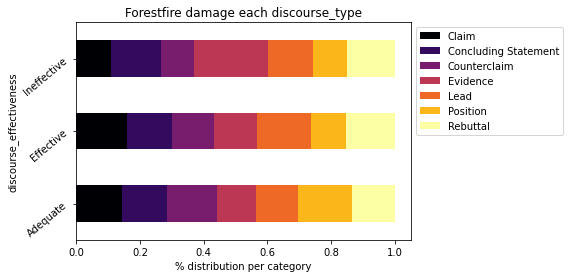
This is much better and more logical!
Most types don’t seem to affect the effectiveness of the discourse.
Most?
It seems that some stand out more than others.
Max occurence – discourse_type
Let’s display the max values for each of the discourse_effectiveness:
For Ineffective:
cross_norm.columns[(cross_norm == cross_norm.loc['Ineffective'].max()).any()].tolist()Output: Evidence
For Adequat:
cross_norm.columns[(cross_norm == cross_norm.loc['Adequate'].max()).any()].tolist()Output: Position
For Effective:
cross_norm.columns[(cross_norm == cross_norm.loc['Effective'].max()).any()].tolist()Output: Lead
In the Univariate Analysis, we saw that most of the long discourses are Effective and Evidence type.
We could have established a link between an Evidence type discourse and an Effective type discourse. But as we see here, the two are not correlated.
Indeed, most Evidence type discourses are Ineffective, while Position types are Adequate and Lead types are Effective.
Normalization is mandatory here to understand the data properly. If we had not done so, we would have come to the conclusion that Claim type discourse is the most useful for Adequate and Effective discourse. This is not true. This bias is due to the lack of data in our dataset (the lack of generalization).
Most of our data are of type Evidence(12,105) and Claim(11,977) while only 2,291 rows are counted for type Lead.
Moreover, another bias may remain. Do we have enough data on Lead to draw a conclusion on this label?
For now, the contest has only one dataset, so let’s assume we do 😉
NLP Data
Discourse Length
Let’s continue on the analysis of discourse length in relation to effectiveness:
plt.figure(figsize=(8,4))
sns.boxplot(data=df, x='discourse_length', y='discourse_effectiveness').set_xlim(-1, 220)
plt.show()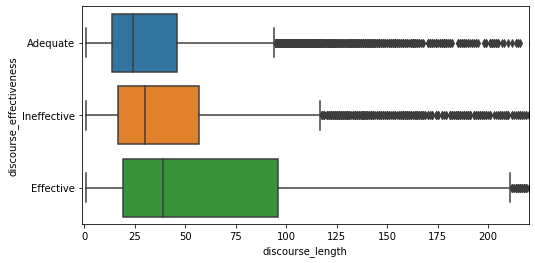
The longer a discourse is, the more likely it is to be Effective. We can also display the average number of words in each category.
df.groupby(['discourse_effectiveness'])['discourse_length'].median()Output:
Adequate: 24
Effective: 39
Ineffective: 30
Words Analysis
Finally, the analysis of words.
Do the words chosen have an impact on the effectiveness of a discourse? If so, we should find disparities in effectiveness.
We start by extracting the discourse_effectiveness column from the dataset and add it to dfb, the encoded one-hot discourses:
dfb['discourse_effectiveness'] = df['discourse_effectiveness']
We will separate this dataset into 3 DataFrame:
EffectiveAdequateIneffective
And analyze the words contained in each of them:
dfb_ineffective = dfb.loc[dfb['discourse_effectiveness'] == 'Ineffective'].drop('discourse_effectiveness', axis=1)
dfb_adequate = dfb.loc[dfb['discourse_effectiveness'] == 'Adequate'].drop('discourse_effectiveness', axis=1)
dfb_effective = dfb.loc[dfb['discourse_effectiveness'] == 'Effective'].drop('discourse_effectiveness', axis=1)As for the Univariate Analysis, we sum the occurrence of each word:
words_sum_ineffective = dfb_ineffective.sum(axis = 0).T
words_sum_adequate = dfb_adequate.sum(axis = 0).T
words_sum_effective = dfb_effective.sum(axis = 0).TWe sort them by descending order, the greatest number of occurrences first:
words_sum_ineffective = words_sum_ineffective.sort_values(ascending=False)
words_sum_adequate = words_sum_adequate.sort_values(ascending=False)
words_sum_effective = words_sum_effective.sort_values(ascending=False)And we take the first 20 occurrences:
words_sum_ineffective_max = words_sum_ineffective.head(20)
words_sum_adequate_max = words_sum_adequate.head(20)
words_sum_effective_max = words_sum_effective.head(20)We can display the graph for each of the DataFrame but here I prefer to group them in a single DataFrame and display the head.
This will allow us to compare more simply the occurrence of words according to the three types of effectiveness.
pd.DataFrame(list(zip(list(words_sum_effective_max.index),
list(words_sum_adequate_max.index),
list(words_sum_ineffective_max.index))),
columns =['Effective', 'Adequate', 'Ineffective']).head(10)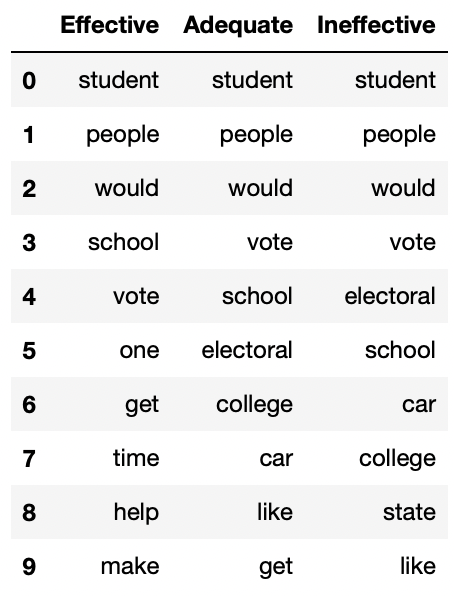
It does not seem that there is a remarkable difference. Neither between the Labels, nor between the Labels and the global dataset.
In fact, usually the difference lies in the following lines. The first ones being always shared on the whole dataset.
Therefore, I invite you to display on your side the 100 or 500 most frequent words according to the discourse_effectiveness and tell us in comments your analysis 🔥
From my personal studies, I know that verbs appear more in effective discourse. Is this true in our dataset? If so, it may be a useful clue for us.
Tags Analysis
To study the occurrence of verbs, we use NLTK tags.
NLTK is an NLP library that can analyze sentences and extract tags.
For example it can identify nouns, verbs, adjectives, etc.
Perfect for us!
Let’s take our words and their occurrences. We’ll create a new word column thanks to the indexes:
words_sum_ineffective = words_sum_ineffective.to_frame()
words_sum_ineffective['word'] = words_sum_ineffective.index
words_sum_adequate = words_sum_adequate.to_frame()
words_sum_adequate['word'] = words_sum_adequate.index
words_sum_effective = words_sum_effective.to_frame()
words_sum_effective['word'] = words_sum_effective.indexWe now have a column representing the number of occurrences and a column representing the word.
Let’s add a last column representing the tag thanks to the pos_tag function of nltk.tag:
from nltk import tag
nltk.download('averaged_perceptron_tagger')
words_sum_ineffective['tag'] = [x[1] for x in tag.pos_tag(words_sum_ineffective['word'])]
words_sum_adequate['tag'] = [x[1] for x in tag.pos_tag(words_sum_adequate['word'])]
words_sum_effective['tag'] = [x[1] for x in tag.pos_tag(words_sum_effective['word'])]Tags are very detailed. For example there are 4 types of verbs (past, present, etc) which all have a different tag. This detail is not interesting for us. Therefore we clean these tags to keep only the essential (one tag by verb, one tag by adjective etc):
def easyTag(x):
if x.startswith('VB'):
x = 'VB'
elif x.startswith('JJ'):
x = 'JJ'
elif x.startswith('RB'):
x = 'RB'
elif x.startswith('NN'):
x = 'NN'
return x
words_sum_ineffective['tag'] = words_sum_ineffective['tag'].apply(lambda x: easyTag(x))
words_sum_adequate['tag'] = words_sum_adequate['tag'].apply(lambda x: easyTag(x))
words_sum_effective['tag'] = words_sum_effective['tag'].apply(lambda x: easyTag(x))
words_sum_ineffective.head(10)
We now have a DataFrame with our tag column:
- NN for nouns
- VB for verbs
- JJ for adjectives
- RB for adverbs
- … (you can consult the rest of the Tags on our article dedicated to the subject)
Finally, we count the number of occurrences per Tag:
def count_tag(words_sum):
tag_count = []
for x in words_sum['tag'].unique():
tmp = []
tmp.append(x)
tmp.append(words_sum[words_sum['tag'] == x][0].sum())
tag_count.append(tmp)
return pd.DataFrame(tag_count, columns= ['tag','count'])
tag_ineffective = count_tag(words_sum_ineffective).sort_values(by=['count'], ascending=False)
tag_adequate = count_tag(words_sum_adequate).sort_values(by=['count'], ascending=False)
tag_effective = count_tag(words_sum_effective).sort_values(by=['count'], ascending=False)And we can display the result:
plt.figure(figsize=(6,8))
plt.subplot(3,1,1)
sns.barplot(x="tag", y="count", data=tag_ineffective.iloc[:6])
plt.title('Tag for Ineffective')
plt.subplot(3,1,2)
sns.barplot(x="tag", y="count", data=tag_adequate.iloc[:6])
plt.title('Tag for Adequate')
plt.subplot(3,1,3)
sns.barplot(x="tag", y="count", data=tag_effective.iloc[:6])
plt.title('Tag for Effective')
plt.tight_layout()
plt.show()
Nouns appear most often in all types of discourse. This seems logical because they compose the majority of the sentences. However, this gives us little information.
Let’s analyze the rest of the tags by omitting the nouns:
plt.figure(figsize=(6,8))
plt.subplot(3,1,1)
sns.barplot(x="tag", y="count", data=tag_ineffective.iloc[1:6], color="#066b8b")
plt.title('Tag for Ineffective')
plt.subplot(3,1,2)
sns.barplot(x="tag", y="count", data=tag_adequate.iloc[1:6], color="#066b8b")
plt.title('Tag for Adequate')
plt.subplot(3,1,3)
sns.barplot(x="tag", y="count", data=tag_effective.iloc[1:6], color="#066b8b")
plt.title('Tag for Effective')
plt.tight_layout()
plt.show()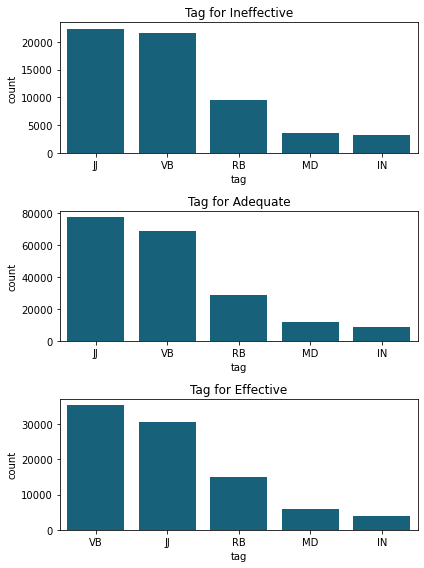
Here, the number of occurrences doesn’t matter. Since Adequate discourse has many more words, there will obviously be more words in each tag of this section.
Here we have to look at the tag ranking.
What we can see is that Effective discourse contains more verbs (VB) than the other types.
Our hypothesis seems to be confirmed!
Let’s go further by analyzing the number of verbs per speech according to the effectiveness.
Average number of verbs by effectiveness
This time we apply pos_tag on all our words preprocessed in df_words.
To recall this DataFrame contains one discourse per line with only the important words (without stopwords, special characters, etc). Using this DataFrame will facilitate tag counting:
list_tags = []
for i in range(len(df_words)):
list_tags.append([easyTag(x[1]) for x in tag.pos_tag(df_words[i])])Then we count the number of verbs in each row:
df_tag = pd.DataFrame(columns=['VB'])
for i in range(len(list_tags)):
df_tag = df_tag.append({'VB': list_tags[i].count('VB')}, ignore_index=True)We extract the discourse_effectiveness column and add it to df_tag:
df_tag['discourse_effectiveness'] = df['discourse_effectiveness']
df_tag.head()
Finally we display the average number of verbs per effectiveness.
For Ineffective:
VB_ineffective = df_tag.loc[df_tag['discourse_effectiveness'] == 'Ineffective']
VB_ineffective['tag_VB'].sum() / len(VB_ineffective)Output: 3.8
For Adequate:
VB_adequate = df_tag.loc[df_tag['discourse_effectiveness'] == 'Adequate']
VB_adequate['tag_VB'].sum() / len(VB_adequate)Output: 2.8
For Effective:
VB_effective = df_tag.loc[df_tag['discourse_effectiveness'] == 'Effective']
VB_effective['tag_VB'].sum() / len(VB_effective)Output: 5.1
Dans un discours Effective on décompte 5 verbe moyens utilisés. C’est 2 de plus que dans un discours Adequate et 1 de plus que dans un discours Ineffective.
Conclusion
To improve a discourse:
- Use about 39 words
- 5 verbs (but also adjectives)
- Have a Lead (a statistic, a quote, a description) in your discourse to grab the reader’s attention and direct them to the thesis.
- Avoid sharing ideas that support assertions, counter-affirmations, or rebuttals (most Evidence type discourses are ineffective).
To go further, there are many analyses that can be done. Questions that we haven’t answered. For example, we could study which words make up Lead vs. Evidence discourse.
Biases still remain, for example the average number of verbs is higher in Effective discourses but the average number of words is higher too. Is this a prerequisite to have an Effective discourse or is it simply a bias of the dataset?
We could analyze this dataset for days and list all the biases. But now that we have a first detailed and consistent analysis, the most important thing is to take action and use a Machine Learning model to achieve the main goal: classify the students’ discourses as “effective”, “adequate” or “ineffective”!
See you in a next post 😉
One last word, if you want to go further and learn about Deep Learning - I've prepared for you the Action plan to Master Neural networks. for you.
7 days of free advice from an Artificial Intelligence engineer to learn how to master neural networks from scratch:
- Plan your training
- Structure your projects
- Develop your Artificial Intelligence algorithms
I have based this program on scientific facts, on approaches proven by researchers, but also on my own techniques, which I have devised as I have gained experience in the field of Deep Learning.
To access it, click here :




